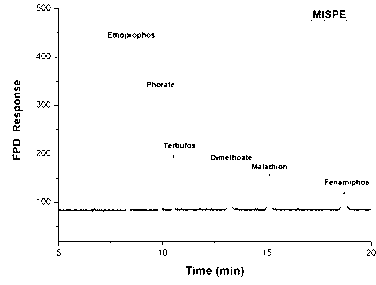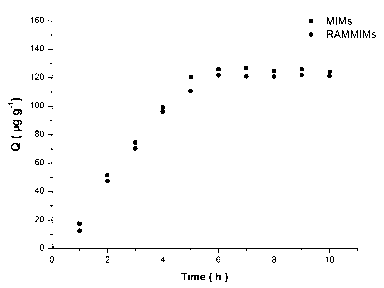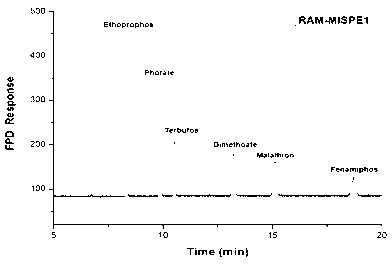Malathion molecularly imprinted polymer and synthetic method of malathion restricted access media-molecularly imprinted polymer
A technology of malathion and molecular imprinting, which is applied in the field of residual pesticide detection, can solve the problems of adsorbent pore blockage, reduce column capacity, shorten column life, etc., and achieve high recovery rate, good extraction effect and low standard deviation.
- Summary
- Abstract
- Description
- Claims
- Application Information
AI Technical Summary
Problems solved by technology
Method used
Image
Examples
Embodiment 1
[0048] Example 1, the synthesis method of malathion molecularly imprinted polymer:
[0049] Accurately measure 0.067mL (0.25mmol) of the template molecule malathion, 0.170mL (2mmol) of the functional monomer MAA (α-methacrylic acid), and 1.889mL of the cross-linking agent EDMA (ethylene glycol dimethacrylate) ( 10mmol) into the test tube (template molecule: functional monomer: crosslinking agent = 1:8:40), then add 24.24mg of initiator AIBN (azobisisobutyronitrile), 5mL of solvent chloroform, shake, and blow nitrogen for 5min Shake it for another 10 minutes to make it fully mixed, seal it, and react in a constant temperature water bath at 70°C for 24 hours. After grinding and sieving, the molecularly imprinted polymer of malathion with a particle size of 75-150 μm is collected. Then wrap it with filter paper, first use methanol / glacial acetic acid (9 / 1, V / V) solution to elute the template molecule in a Soxhlet extractor, and then change to pure methanol for elution until no t...
Embodiment 2
[0109] Example 2. Synthesis method of malathion molecularly imprinted microspheres (precipitation polymerization method):
[0110] (1) Take the template molecule malathion (0.268mL, 1.0mmol) and the functional monomer MAA (0.509mL, 6.0mmol) into a 250mL round-bottom flask, add 40mL of chloroform solvent, put the magnet on the magnetic stirrer to pre- Polymerize for 5h, then add cross-linking agent EDMA (5.642mL, 30.0mmol) and initiator AIBN (0.096g), and finally add 120mL chloroform solvent. Put the round bottom flask containing this mixed solution into a constant temperature magnetic stirrer, and the temperature and speed of the constant temperature magnetic stirrer were set to 70°C and 150r min respectively -1 . Reaction under these conditions for 10h. Molecularly imprinted microspheres were obtained.
[0111] The composition ratio and method of the non-molecularly imprinted microspheres are the same as above, except that the template molecule malathion is not added.
[...
Embodiment 3
[0113] Example 3. Synthesis method of limited-access medium-malathion molecularly imprinted microspheres (precipitation polymerization method): including the synthesis of limited-access medium-molecularly imprinted microspheres, the removal of template molecules in the microspheres and the epoxy on the surface of the microspheres Hydrolytic ring opening of the ring.
[0114] (1) Synthesis of restricted access medium-molecularly imprinted microspheres: A new monomer GMA (glycidyl methacrylate) (0.199 mL, 6.0 mmol) was added to the mixed solution in Example 2 (1), namely The ratio of template molecule, MAA, GMA and EDMA is 1:6:6:30, add initiator AIBN0.146g and 150mL chloroform solvent to a 250mL round bottom flask. Others are the same as embodiment 2 (1).
[0115] The steps for template molecule removal are the same as in Example 2(2).
[0116] The same ratio and method were used to prepare restricted access medium-non-molecularly imprinted microspheres (without adding templa...
PUM
 Login to View More
Login to View More Abstract
Description
Claims
Application Information
 Login to View More
Login to View More - R&D
- Intellectual Property
- Life Sciences
- Materials
- Tech Scout
- Unparalleled Data Quality
- Higher Quality Content
- 60% Fewer Hallucinations
Browse by: Latest US Patents, China's latest patents, Technical Efficacy Thesaurus, Application Domain, Technology Topic, Popular Technical Reports.
© 2025 PatSnap. All rights reserved.Legal|Privacy policy|Modern Slavery Act Transparency Statement|Sitemap|About US| Contact US: help@patsnap.com



